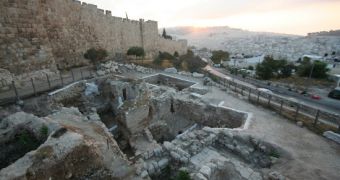Archaeologists carrying out excavations in Jerusalem claim to have found the remains of a mansion dating back to the biblical era.
The building sits on Mount Zion, and specialists estimate that it is some 2,000 years old.
Judging by the artifacts found inside it, archaeologists suspect that, during the early Roman period, it served as a home for an elite Jewish family.
Thus, the mansion used to house a fairly impressive bath chamber that sat not far from a ritual cleansing pool known as a mikveh.
Specialists say that such arrangements have been documented before.
In fact, a nearly identical bath chamber and cleansing pool have recently been uncovered inside a nearby mansion that researchers know for a fact used to belong to a priestly Jewish family.
“I wouldn't hesitate to say that the people who made that bathroom probably were the same ones who made this one. It's almost identical, not only in the way it's made, but also in the finishing touches, like the edge of the bath itself,” archaeologist Shimon Gibson said.
Specialists hope that, by analyzing this mansion's architecture and the things inside it, they will be able to shed new light on how the wealthy class of Jerusalem lived during Jesus' time.
Besides, they expect that their findings will supplement the text of the Bible and other religious writings.
Specifically, the mansion and its contents will help historians better understand what it was exactly that Jesus disapproved of about these wealthy people.
“If this turns out to be the priestly residence of a wealthy first-century Jewish family, it immediately connects not just to the elite of Jerusalem — the aristocrats, the rich and famous of that day — but to Jesus himself,” said researcher James Tabor, as cited by LiveScience.
“Jesus, in fact, criticizes the wealth of this class. He talks about their clothing and their long robes and their finery, and, in a sense, pokes fun at it. So for us to get closer to understanding that – to supplement the text – it could be really fascinating,” he further argued.
The researchers wish to continue excavating the area in 2014 and 2015. Once their work is complete, the mansion's ruins will be open to visitors.

 14 DAY TRIAL //
14 DAY TRIAL //